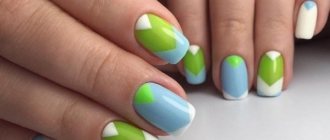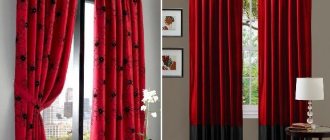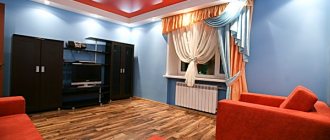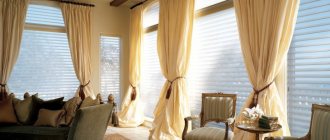Making tapestries
Simply put, a tapestry is a fabric carpet that depicts various landscapes. Initially, craftsmen manually created their masterpieces from gold, silver, wool and also silk threads. It took a lot of time to make one tapestry, and the master's masterpiece cost a lot of money.
Today, everything has changed. In order to create one beautiful tapestry, you only need high-tech equipment and a certain period of time. There is a noticeable difference between human work and robot work. Firstly, the landscape is more realistic, and secondly, production costs are not so high.
Nowadays, decorative tapestries are unusual curtains, exquisite bedspreads and pillowcases, the best alternative to a carpet, as well as panels, tablecloths, paintings, draperies and much more!
Tapestries in various styles
Despite the fact that after the collapse of the USSR, one began to hear from everywhere “a carpet on a wall or on a bed is a relic of the past, this is a village,” many people are in no hurry to abandon this not only beautiful, but also a warm-preserving interior detail. And they are doing the right thing, not every carpet is an atavism that cannot fit into the general style; many of them are so original that they look harmonious in the most popular trends today. Tapestry fabric provides such a wide field for imagination that few would dare call skillful hand-woven work or embroidery an ordinary old carpet.
We create a cozy atmosphere in the house with the help of tapestry paintings
Textile decoration, soft lighting - everything in your home should be conducive to a pleasant pastime and a relaxing holiday. Delightful tapestry canvases are the ideal solution if you dream of making your home cozy and follow current trends in interior design.
Made from woolen threads and artificial raw materials, such textiles will be a winning decoration for an apartment, office, hotel, made in the Baroque, English or French style. Art products will give coziness and comfort, especially with the onset of bad weather, when there is so little warmth and bright colors!
Decorative tapestries are extremely practical and durable. Such products are the best and most original solution for those who are endowed with artistic taste and prefer to surround themselves with easy-to-care, but high-quality and original products.
Picturesque panels and colorful paintings will become a bright accent, ennoble and refresh both residential and office space. In addition, tapestries are a beautiful gift for friends and family, which will not be difficult to choose due to the variety of storylines.
Tastefully selected decorative tapestries of various themes will become the basis for creating a comfortable homely atmosphere. Colorful products of modern design at affordable prices will make your home brighter and bring a touch of novelty and freshness.
Rooms and drawings
- Mythical creatures. You need to be careful with them, since they seriously occupy the imagination and indirectly affect the psyche. Such drawings can be hung anywhere, but not in a place of relaxation - the bedroom.
- Architectural structures and heraldry. Suitable for any room, but will look good only in rooms with fairly high ceilings and additions such as oak furniture, massive doors, and antiques.
- Reproductions of famous painters. They look good in the living room; you can spend a long time in them thinking and traveling inside on long evenings by the fireplace, living through historical events.
- Floristry and still lifes. They are appropriate in absolutely any room, since the themes are light and do not excite the imagination too much.
- Abstractions - they look most appropriate as drawings of covers for sofas and armchairs, however, as wall decor they can bring originality and effectiveness to the interior.
This year's tapestry products can in no way be considered an echo from the past; the designers endowed them with original moments and flavor. The tapestry today is a unique bridge, skillfully connecting together the masterpieces of masters of past centuries and the present.
Succumbing to the spirit of the harsh Russian winters, in 2020 the world's leading designers decided to give a second life to wall hangings and heavy bedspreads, but today these are no longer those terrible Soviet “masterpieces”, but real objects of art, which the tapestry catalog will help us understand. The photographs presented at numerous traveling handicraft exhibitions and websites amaze with the abundance of interesting topics; the subjects of the images of some of the works are comparable to rare paintings.
However, before you pay tribute to fashion and run to the store for an original piece of furniture, you need to understand what a tapestry is and how it is appropriate to attach this fabric to the walls. Tapestries are woven carpets, bedspreads or handmade paintings made from silk or wool threads. The technology consists in the fact that the process takes place in detail in several stages, and the finished parts, after their completion, are sewn together, and the types of threads are often mixed.
Tapestries were made from wool and silk fibers by cross-weaving colored threads
People who love this type of art mostly prefer to purchase ready-made products at flea markets or in specialized departments of a fabric store, but you can make a tapestry with your own hands. To do this, you will need to buy the necessary material, equipment, study the technique from a book or any article from the Internet - and after a while you will be able to surprise your loved ones and guests with your own original decorative element. Today you don’t need to look for all the components separately; you can buy them all together in specialized handicraft departments that sell ready-made kits.
Carpets usually depict some kind of plot or ornament
If you, however, trust professionals more or simply don’t want to wait and work for a long time, but are eager to immediately get a tapestry on the wall in one of the rooms, you can go to the store and decide on the choice of pattern and type of embroidery. However, first you should correlate the future painting, bedspread or carpet with the overall style of the room; it wouldn’t hurt to preview the options in the photos offered on the Internet.
How to choose a tapestry picture or tapestry for the interior of your home?
Before you go to the store, you need to decide for yourself what role tapestries will play in the interior. Designers argue that a tapestry painting can be a powerful tool that tips the scales either towards an energetic interior or towards a comfortable and peaceful atmosphere.
It's up to you to decide which landscape to choose. But keep in mind that a tapestry can not only make the room taller and wider visually, but also adjust the proportions of the furniture in the room. Of course, in addition to tapestries, mirrors can help visually expand a room.
As mentioned earlier, a tapestry painting is a powerful weapon. What is meant? This piece of decor can either be practically invisible, not stand out against the background of the overall design of the room, or be the center of the universe.
Having decided for yourself what role the tapestry will play in the interior of your apartment, you can finally choose the pattern and color scheme.
Tapestries in the interior: ancient and modern
A tapestry - a woven carpet painting with a stylized floral pattern or genre plot - has served as interior decoration since the Middle Ages. In ancient castles and mansions, tapestries on the walls also served a practical function: they insulated the room (natural stone does not hold heat well and often becomes damp). Nowadays, tapestries in the interior are used to emphasize the sophistication of the furnishings and give it originality.
A decorative tapestry can be used as an interior accessory in many ways, but the most common is to mount it on the wall. A narrow, not too heavy tapestry can be turned into a “banner” with two rigid bases of thin slats (round or flat) at the top and bottom. Large woven paintings are usually stretched over a frame and framed (baguette), which makes the tapestry even closer to a work of painting. Tapestry fabrics are also used to make bedspreads for upholstered furniture, covers for decorative pillows and even curtains; True, such curtains turn out to be very heavy, and therefore they require a metal curtain rod with reliable brackets and strong fastening clips or eyelets.
Tapestries in the interior are best combined with classical and “palace” styles (empire, rococo, baroque); in such an environment - in combination with a decorative fireplace, Venetian plaster or textile wallpaper on the walls, couches and Chippendale chairs - they look completely natural. However, you can use tapestries in other design styles - retro, vintage, shabby chic, as well as in country and ethnic styles (primarily oriental). Modern tapestries differ markedly from their predecessors in their color scheme and subject matter; many of them are copies of famous paintings of various genres, including impressionist, avant-garde or abstract. Such a tapestry is quite appropriate even in a minimalist, art deco or contemporary interior - it will play the role of a picture, only woven from threads, and not painted with brush strokes. The soft texture of the tapestry successfully complements the simple and austere interior, which is dominated by smooth glossy surfaces; if you place the canvas in a shallow niche with lighting or complement it with an original frame (wicker, metal) - the tapestry will become a truly unique design detail.
The best posts
- How to make a plasterboard ceiling in the kitchen with your own hands
- Waiting room design: photos of ready-made solutions
- Wall clock in the living room - 80 photos of original design ideas
- Mini-walls for the living room - 100 photos of new designs
- Carpet in the living room - 100 photos of fashionable design for 2020
- Brick living room - 75 photos of ideas on how to beautifully decorate a living room
- IKEA living rooms - 100 photos of the best models from the 2019 catalog
- Living room with two windows - 85 photos of stylish design options
Related article: How to wash linoleum to make it shine at home
Characteristics of care
It is better not to clean a material of this kind like a tapestry on your own. Very small items can still be put into a gentle washing machine, but larger items are best dry cleaned.
When selecting, we take into account the color and stylistic design of the room
On any tapestry product there is a small instruction from the manufacturer for caring for the product. These rules must be strictly adhered to so that the item lasts longer.
This material is used to make curtains, bedspreads and covers for sofas, beds, and pillowcases. You can find home decorations such as napkins, tablecloths, and panels. There is an individual direction in tapestry products - icons. They not only decorate the room, but also serve as a symbol of well-being and home peace.
Original headboard design
Tapestry curtains have good performance characteristics and are wear-resistant. Such curtains will not fade in the sun, lumps will not appear on them, and they will retain their elegant appearance for a very long time. Natural material is soft and gentle to the touch.
Tapestry curtains are wear-resistant
Similar curtains in the area for receiving guests will add more festiveness to the interior. Also, they are dense and will protect from excess sun rays. Even silhouettes will not be visible through them.
Most suitable for guest room
For the classic style, choose heavy tapestry curtains. The canvas will fit perfectly with any tulle; the main thing is to ensure high-quality fastening for the curtains.
For large rooms, choose curtains in dark colors, for example, black, blue, burgundy, brown, etc. For small rooms, light, soft shades are best. They can help visually make the space in the room larger.
For small rooms, choose light-colored curtains
Tapestry curtains are not suitable for these styles such as minimalism, Loft or hi-tech. However, if you approach the design of the room wisely, then similar things can be combined correctly.
Compose correctly with the chosen style
Tapestry pillows are very comfortable. They are in great demand. A tapestry is a plot or ornamental design on strong, lint-free fabrics. These designs are made by using colored wool and silk threads. This fabric is not only strong, but also beautiful.
Tapestry pillows are a bright accent for completely different designs
Tapestry pillowcases are a great substitute for buying new pillows. By the way, they can be a place for storage. If you put blankets and spare linens there, it will save space in the closet.
Bedspreads and capes
A thick blanket will not only make your sofa, bed or chair more beautiful, but will also protect you from dirt. After all, it’s easier to clean a bedspread, even with chemical cleaning, than a sofa. Tapestry bedspreads are more functional; they will not have puffs or pills.
These blankets are more functional
This blanket will help renew your sofa. It will hide all the disadvantages on the furniture (stains, scuffs, puffs).
The most popular use of tapestries is in the design of carpets
This can be explained by the fact that dirt will not be noticeable in a small drawing. Regardless of the daily use of the bedspread, the appearance will remain the same for a long time.
You can also choose a tapestry bedspread for a children's room. There are special prints for kids, with interesting drawings, characters from cartoon films, superheroes, etc. A similar element will decorate a child’s room.
Bedspread with celestial elephants for a children's room
Paintings and panels
The tapestry panel contains artistic and decorative elements. With its help you can decorate the walls of your house in an unusual way.
Noble tapestries are passed down from generation to generation
The subjects for tapestries are:
- scenes from the Bible and mythology;
- stories from history;
- ornaments;
- church architecture;
- different images of animals;
- colors.
They can safely be called fabric carpets
You can pick up copies of famous paintings, landscapes, still lifes, etc.
Such a panel will look good on a wall painted white. It can replace a fresco or painting on the wall surface. If the living space is rented, and there is no desire to do repairs, but you want to update it, then tapestry paintings will come to the rescue.
Gold threads and silk raw materials, dyed with real dyes, are constantly used
This painting can be used to beautifully decorate a bedroom by hanging it above the bed, or two small paintings on both sides.
You can add charm and sophistication to a classic-style interior with the help of Renaissance-style panels. Such paintings look great in a work office or home library.
Look great in a work office or library
The picture can be hung over a small table, and the entire composition can be complemented with small lamps on both sides.
A tapestry picture can be hung in a bedroom, living room, nursery and even a hallway. In the latter option, if you add a panel with small hooks and pockets, making it a place to store keys, then it will fit perfectly into the hallway.
Really fits in any room
A painting or tapestry panel can help give even simple, one-tone wallpaper more luxury. An appropriately selected pattern will visually correct the shape of the room.
Design tips from Mobilicasa: tapestry in a modern interior
Today we’ll talk about tapestries, their ability to be used in a modern interior, and how to place them indoors.
- 2 Old and new applications
- 3 3 rules for indoor placement
- 4 3 tips for choosing
Tapestry in history: warm and beautiful
Tapestries, expensive wall tapestries woven by hand by weaving fibers by hand, spread throughout France, and then throughout Europe, about four centuries ago. They were used to insulate and at the same time decorate the walls. Long before this, similar woven paintings were made in Ancient Egypt. Handmade ones have always been highly valued and are still used to decorate walls. Linen or wool threads are used in production, and sometimes silk is added. Today, most tapestries are made by machine.
The Mobilikaza salon will help bring luxury into your home with Bakokko furniture, known for its sophistication and beauty for about 6 decades.
Old and new applications
With the development of mankind, the tapestry partially came down from the walls and found its use in furniture upholstery, bedspreads, decorative pillowcases and even in children's toys. However, real tapestries remain an interesting option for complementing an interior in a classic style, country style, or, depending on the picture shown, even minimalist style. In addition to traditional “smooth” tapestries, textured and multi-level ones began to be produced.
- Role in the apartment: wall decoration to create a themed area, additional sound insulation and insulation.
- Role in a country house: creating a special atmosphere, simple but stylish decoration of rooms.
3 rules for indoor placement
- Compliance of the plot with the style and purpose of the room: a tapestry with a historical plot or a reproduction of a famous painting would be appropriate in the library; in the dining room - a small still life or a framed domestic scene; in the bedroom, studio - abstraction, romantic or architectural plot.
- The tapestry is always the central detail on the wall. It is not allowed to be covered or supplemented with other objects (paintings). It is best to avoid placing the tapestry in a small, narrow room.
- The combination of the tapestry in texture and color with bedspreads, curtains, wallpaper, if any in the room, is an indispensable condition.
With a variety of styles to choose from, we always pay attention to small but important details. Italian coffee tables in the Art Nouveau style, combining innovation and excellent taste, are an integral part of a stylish interior.
3 tips for choosing
- It is better to purchase a tapestry not in the market, but in a specialized store. Take an interest in the composition of the threads. Smooth linen tapestries are the most natural and durable.
- A machine-made canvas costs around $700 if we are talking about a tapestry covering an entire wall. Handmade tapestries cost 2-3 times more.
- When planning to purchase a tapestry in another country, be aware of the shipping regulations: some tapestries cannot be exported as they are considered works of art.
- Author: Evgeniy
Rate this article:
- 5
- 4
- 3
- 2
- 1
(0 votes, average: 0 out of 5)
Share with your friends!
Stabilized moss and plants. Application in the interior
How to create a comfortable interior in a small space - says Mobilicasa











